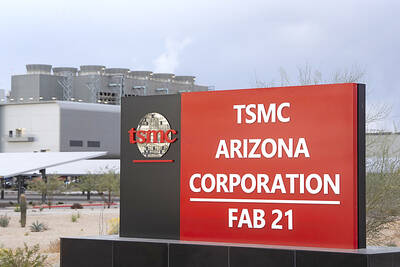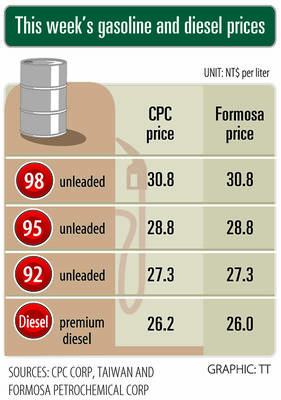The total output of the nation’s computer manufacturing sector last year reached NT$321.5 billion (US$10.54 billion), its highest level since 2003, the Ministry of Economic Affairs said yesterday.
The ministry attributed last year’s strong performance to easing component shortages, as well as emerging technologies such as the Internet of Things (IoT), artificial intelligence and cloud computing driving up demand in industrial supply chains.
Servers, which last year accounted for 60.3 percent of the computer manufacturing sector, performed the best with an output of NT$194 billion.

Photo: CNA
That was a 59.9 percent year-on-year increase in output, and came on the back of growing orders received by Taiwanese manufacturers for cloud computing services in the US, the ministry said.
Department of Statistics Deputy Director-General Huang Wei-jie (黃偉傑) said that demand for remote processing came primarily from US companies, such as Meta Platforms Inc’s Facebook, Amazon.com Inc and Alphabet Inc’s Google.
However, due to an ongoing US-China trade dispute and information security considerations, many of orders have gradually shifted away from China, driving a substantial increase in demand for servers made by Taiwan-based manufacturers, Huang said.
Meanwhile, laptop computers accounted for 22.5 of the sector last year, with an output of NT$72.4 billion, up 25.8 percent year-on-year.
This was followed by industrial computers at NT$50.1 billion, with an annual increase of 45.3 percent and comprising 15.6 percent of the overall sector.
The ministry attributed the sharp year-on-year growth for industrial computers to robust demand for industrial IoT devices and medical applications, as well as retailers undertaking digital transformations.
In the first three months of the year, the US was Taiwan’s largest computer export market at 65.6 percent, followed by China (including Hong Kong) at 5.8 percent and the Netherlands at 5.4 percent.

Taiwan Semiconductor Manufacturing Co (TSMC, 台積電), the world’s biggest contract chipmaker, booked its first-ever profit from its Arizona subsidiary in the first half of this year, four years after operations began, a company financial statement showed. Wholly owned by TSMC, the Arizona unit contributed NT$4.52 billion (US$150.1 million) in net profit, compared with a loss of NT$4.34 billion a year earlier, the statement showed. The company attributed the turnaround to strong market demand and high factory utilization. The Arizona unit counts Apple Inc, Nvidia Corp and Advanced Micro Devices Inc among its major customers. The firm’s first fab in Arizona began high-volume production

VOTE OF CONFIDENCE: The Japanese company is adding Intel to an investment portfolio that includes artificial intelligence linchpins Nvidia Corp and TSMC Softbank Group Corp agreed to buy US$2 billion of Intel Corp stock, a surprise deal to shore up a struggling US name while boosting its own chip ambitions. The Japanese company, which is adding Intel to an investment portfolio that includes artificial intelligence (AI) linchpins Nvidia Corp and Taiwan Semiconductor Manufacturing Co (TSMC, 台積電), is to pay US$23 a share — a small discount to Intel’s last close. Shares of the US chipmaker, which would issue new stock to Softbank, surged more than 5 percent in after-hours trading. Softbank’s stock fell as much as 5.4 percent on Tuesday in Tokyo, its

COLLABORATION: Softbank would supply manufacturing gear to the factory, and a joint venture would make AI data center equipment, Young Liu said Hon Hai Precision Industry Co (鴻海精密) would operate a US factory owned by Softbank Group Corp, setting up what is in the running to be the first manufacturing site in the Japanese company’s US$500 billion Stargate venture with OpenAI and Oracle Corp. Softbank is acquiring Hon Hai’s electric-vehicle plant in Ohio, but the Taiwanese company would continue to run the complex after turning it into an artificial intelligence (AI) server production plant, Hon Hai chairman Young Liu (劉揚偉) said yesterday. Softbank would supply manufacturing gear to the factory, and a joint venture between the two companies would make AI data

The prices of gasoline and diesel at domestic fuel stations are to rise NT$0.1 and NT$0.4 per liter this week respectively, after international crude oil prices rose last week, CPC Corp, Taiwan (台灣中油) and Formosa Petrochemical Corp (台塑石化) announced yesterday. Effective today, gasoline prices at CPC and Formosa stations are to rise to NT$27.3, NT$28.8 and NT$30.8 per liter for 92, 95 and 98-octane unleaded gasoline respectively, the companies said in separate statements. The price of premium diesel is to rise to NT$26.2 per liter at CPC stations and NT$26 at Formosa pumps, they said. The announcements came after international crude oil prices